| Article ID | Journal | Published Year | Pages | File Type |
|---|---|---|---|---|
| 3804871 | Medicine | 2012 | 5 Pages |
Opportunistic infections are a major cause of morbidity and mortality in severely immunocompromised patients, such as those receiving chemotherapy or with haematological malignancy, aplastic anaemia or HIV infection, or recipients of solid-organ or stem cell transplants. In addition, the increasing use of biological therapies will result in more patients at risk of opportunistic infections, albeit to a lesser degree than classic causes of immunocompromise. The type and degree of immune defect dictates the profile of potential opportunistic pathogens; T-cell mediated defects increase the risk of viral (cytomegalovirus and respiratory viruses) and Pneumocystis jirovecii infections, whereas neutrophil defects are associated with bacterial pneumonia and invasive aspergillosis. However, patients often have combinations of immune defects and a wide range of other opportunistic infections can cause pneumonia. The radiological pattern of disease (best assessed by CT scan) and speed of onset also help identify the likely pathogen(s), which can then be supported by targeted investigation including early use of bronchoscopy in selected patients. Rapid and expert clinical assessment can identify the most likely pathogens, which can then be treated aggressively and so provide the best opportunity for a positive outcome.
